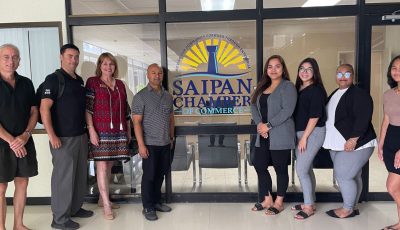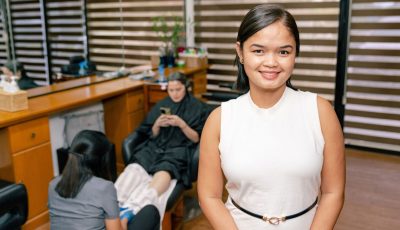NMC seeks entry into Sea Grant program
National Sea Grant officials met with the Northern Marianas College for the first time late last week, as the CNMI’s only college looks to enter the four-stage process in becoming a designated Sea Grant institution.

Northern Marianas College president Dr. Sharon Hart poses for a photo with visiting Sea Grant and other college officials after a meeting last week. (Dennis B. Chan)
The officials visiting were Sea Grant advisory council chair Rolland Schmitten, Virginia Sea Grant director Troy Hartley, National Oceanic and Atmospheric Administration extension leader Michael Liffman, and NOAA Coral Reef Conservation program management liaison Paulo Maurin.
In the works right now is a concept paper, or project proposal, to enter the program. The University of Guam, now in stage two or in the “coherent area program” of the process, began with a project in extension and environmental literacy. The last stages move from “institutional program” to “Sea Grant College.”
For NMC’s part, their project will be led by the college’s Cooperative Research Extension and Education services, among other officials.
“We will be submitting our project proposal. Step one is where we are going next,” college president Sharon Hart said, with a focus on aquaculture.
“It was really important to have these folks out here so they can see and understand what we can bring to the table but also see our challenges and opportunities that lie ahead—I think there are terrific opportunities ahead that can really help the CNMI in the long run through Sea Grant,” she said.
Hart believes it will be a “smooth move” and transition into the Sea Grant process because their extension program has been very involved in aquaculture in years past.
Right now, the focus is on rabbit fish production, according to NMC aquaculture specialist Michael Ogo who, along with another CREES official, participated in the four-year program review of UOG’s Sea Grant program by the visiting officials last week.
From sitting in on this review, they learned the “the importance of listening to stakeholders and listening to the community in coming up with an idea” to get a better understanding of what it takes to become a Sea Grant institution.
“We are really pleased that they came out here. Our dynamics are a little bit different than some of the states. We are appreciate that they took the time to come out here and appreciate of the environment we are working in, and the context and challenges we are facing here as small Pacific islands,” added acting dean of CREES Patricia Coleman.
Schmitten said they met with NMC to see the island and discuss opportunities for a Sea Grant status.
“One of the things we are exploring are the needs of Saipan, and what NMC is doing to address those issues from the standpoint of coastal and marine type resources,” Schmitten said. “We’ve been talking primarily about aquaculture related issues.”
He said the Sea Grant programs are based on “local needs.”
“Some of things we are interested in is the effect of climate change and how communities can adapt to those impending changes, whether it’s impending changes to fisheries, impending changes to coastal resource communities that might be vulnerable,” he said.
He also pointed to environmental literacy. “It’s really sad how very little people know about their coastal and marine environment.”
According to Hartley, the “sea grant approach and role” uses the application of science to solve real world problems. “How you move the best science we have out into the field, into somebody’s hands who’s going to make a decision—and is going to make a better decision—because they have that science,” he said.
Maurin also pointed to the “strategic importance of where” the CNMI and Guam sits in the Micronesia region. “It has the potential to become the hub of a lot of the U.S. activities in the region. There is in some ways a competitive environmental advantage—if you look at the marine environment here, it is in some ways very different from the ones in other parts of Hawaii or American Samoa. Some of the social issues are similar but are still different.”
“It gives the opportunity to study and address challenges that are very unique in the region and study factors and environments that are not found anywhere else,” he said.



























